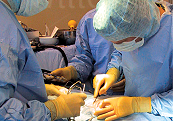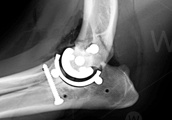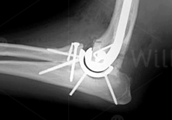Why Should I Bring my Pet to Willows for Total Elbow Replacement Surgery?
Willows is one of Europe’s leading small animal Orthopaedic referral centres treating over 1000 new patients a year. Our state-of-the-art hospital is led by internationally renowned Specialists committed to providing the highest standards of care.
Our Orthopaedic Surgeons are supported by our multi-disciplinary team of Specialists across a number of disciplines including; Anaesthesia, Diagnostic Imaging and Emergency and Critical Care. Willows has a large dedicated team of Nurses and clinical support staff available 24 hours a day, every day of the year to provide the best possible care for your pet.
What is Total Elbow Replacement Surgery?
Total Elbow Replacement (TER) involves replacing the elbow joint surfaces with metal and plastic prostheses. The aim of the procedure is to alleviate pain and improve forelimb function.
Heading What are the Signs that my Dog needs a Total Elbow Replacement?
TER surgery is a major procedure with a relatively high risk of complications. As a result it is only performed in dogs with severe elbow pain where the benefits of surgery outweigh the possible risks, and where alternative methods of treatment are less likely to be successful.
TER can be considered for dogs with persistently painful elbows that are not responding satisfactorily to medical management and where other more straightforward operations are unlikely to be successful. The most common cause of elbow joint pain is osteoarthritis associated with elbow dysplasia.

Are there any alternatives to TER Surgery?
Although elbow pain is common in dogs, most patients can be managed using medication or more straightforward operations. TER is considered for dogs whose elbows remain persistently painful. Other options for a very painful elbow include arthrodesis (fusion of the elbow joint) or amputation of the limb.
Fig 1: Joint replacements are amongst the most challenging operations performed

What does TER Surgery Involve?
Dogs have to be evaluated to see if they are a suitable patient for TER surgery. This is done on a separate day to the surgery; often a few weeks before. A CT scan and specific X-rays of the elbow are obtained to plan the surgery in detail.
A team of Specialist Surgeons, Anaesthetists and several Nurses will work together to perform the procedure. Two principle types of elbow joint replacement are performed; SIRIUS and TATE, each having their advantages and disadvantages.
The operations are performed through an incision over the elbow joint. Careful preparation of the three bones that make up the elbow (the humerus, radius and ulna) is necessary prior to placement of the relevant prostheses. The artificial components are inserted into the space where bone has been removed. The tissue that surrounds the joint is carefully stitched prior to closure of the rest of the incision.
X-rays are obtained at the end of the operation to check the position of the prostheses. A padded dressing may be applied to the limb following surgery.

Fig 2: Post-operative X-rays (looking from the side) of a TATE elbow replacement that uses cementless prostheses

Fig 3: Post-operative radiograph (looking from the side) of a SIRIUS elbow replacement that uses a combination of cemented and cementless prostheses
Are there any Reasons TER Surgery would not be performed?
Dogs with elbow dysplasia/osteoarthritis, no matter how severe, are not suitable for TER surgery if signs of pain and lameness are mild and readily controlled by conservative measures.
Candidates for TER surgery must be in good general health. Blood tests may be recommended to ensure that internal organs, for example the liver and kidneys, are working properly. It is very important that there is no evidence of infection in the elbow joint; if there is any doubt it may be necessary to collect a sample of fluid from the joint for analysis.
What can I Expect if my Pet has a Total Elbow Replacement?
Aftercare following TER surgery is very important with rehabilitation taking many months. Courses of painkillers are prescribed at discharge. Exercise must be very restricted for the first few weeks until the joint capsule and other soft tissues heal. Short walks on the lead can be allowed for toileting purposes. At other times confinement to a pen or a small room is necessary to avoid jumping and climbing. After a few weeks, exercise may be gradually increased in a controlled manner. Hydrotherapy may be recommended.
The first check-up at Willows is usually two weeks after the operation. Limb and elbow function are evaluated at this time. Depending on progress advice is given regarding increasing exercise. Further check-ups are performed after six and twelve weeks, when radiographs are obtained to evaluate the prostheses. Further clinical and radiographic examination is recommended annually thereafter.
Risks and Complications
Total Elbow Replacement surgery is a major procedure. Elbow pain is reduced and limb function improved in the majority of dogs. However, there are potential complications including fracture of the humerus or ulna, loosening of the prostheses and infection.
To save this page as a PDF, click the button and make sure “Save as PDF” is selected.
Orthopaedics
Find out more
To assist owners in understanding more about Orthopaedics we have put together a range of information sheets to talk you through the some of the more common orthopaedic conditions seen and treated by our Specialists.

